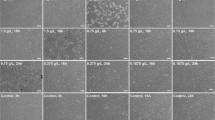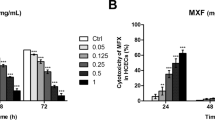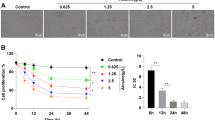Abstract
used anesthetic for eye surgery, may damage the human corneal epithelium (HCEP) and impair vision. The cytotoxicity of PPC on the HCEP and its possible mechanism of action remain unclear. Therefore, we treated HCEP cells with 0.15625-5 g/L PPC for 1-28 h and monitored its effects. We found that PPC at concentrations above 0.15625 g/L (1/32 of the clinical therapeutic dose) induced dose- and time-dependent cytotoxic morphological changes and reduced cell viability. Moreover, PPC induced G1 phase arrest, plasma membrane permeability, phosphatidylserine externalization, DNA fragmentation, and apoptotic body formation. Furthermore, PPC induced activation of caspase-3, -8, and -9, disrupted mitochondrial transmembrane potential, upregulated BAD and down-regulated Bcl-2 expression, and induced the release of cytochrome c and apoptosis-inducing factor from the mitochondria. Our results indicate that PPC is cytotoxic to HCEP cells and induces apoptosis via a death receptor-mediated mitochondrion-dependent pathway.
Similar content being viewed by others
References
Kinoshita, S. et al. Characteristics of the human ocular surface epithelium. Prog Retin Eye Res 20:639–673 (2001).
Patel, S., Marshall, J. & Fitzke, F. W. 3rd. Refractive index of the human corneal epithelium and stroma. J Refract Surg 11:100–105 (1995).
Kurpakus-Wheater, M., Kernacki, K. A. & Hazlett, L. D. Maintaining corneal integrity how the “window” stays clear. Prog Histochem Cytochem 36:185–259 (2001).
Notara, M. et al. In sickness and in health: Corneal epithelial stem cell biology, pathology and therapy. Exp Eye Res 90:188–195 (2010).
Loma, P., Guzman-Aranguez, A., Pérez de Lara, M. J. & Pintor, J. Diadenosine tetraphosphate induces tight junction disassembly thus increasing corneal epithelial permeability. Br J Pharmacol 172:1045–1058 (2015).
Bartfield, J. M., Holmes, T. J. & Raccio-Robak, N. A comparison of proparacaine hydrochloride and tetracaine eye anesthetics. Acad Emerg Med 1:364–367 (1994).
Kiliç, A. & Gürler, B. Subtenon lidocaine vs topical proparacaine in adult strabismus surgery. Ann Ophthalmol (Skokie) 38:201–206 (2006).
Peng, Y. Y., Jin, Y. X., Chen, C. F., Yu, X. P. & Zheng, J. W. Reduced emergence agitation with proparacaine hydrochloride eye drops after general anaesthesia for paediatric strabismus surgery. Int J Nursing Sci 2:58–60 (2015).
Judge, A. J., Najafi, K., Lee, D. A. & Miller, K. M. Corneal endothelial toxicity of topical anesthesia. Ophthalmology 104:1373–1379 (1997).
Wen, Q., Fan, T. J., Bai, S. R. & Sui, Y. L. Cytotoxicity of proparacaine to human corneal endothelial cells in vitro. J Toxicol Sci 40:427–436 (2015).
Hou, Y. C., Wang, I. J. & Hu, F. R. Ring keratitis associated with topical abuse of a dilute anesthetic after refractive surgery. J Formos Med Assoc 108:967–972 (2009).
Grant, L. G. & Acosta, D. Comparative toxicity of tetracaine, proparacaine and cocaine evaluated with primary cultures of rabbit corneal epithelial cells. Exp Eye Res 58:469–478 (1994).
Fan, T. J. et al. Establishment of an untransfected human corneal epithelial cell line and its biocompatibility with denuded amniotic membrane. Int J Ophthalmol 4:228–234 (2011).
Xu, B. et al. In vitro reconstruction and characterization of tissue-engineered human corneal epithelium with seeder cells from an untransfected human corneal epithelial cell line. Int J Ophthalmol 5:281–285 (2012).
Xu, B. et al. Transplantation of tissue-engineered human corneal epithelium in limbal stem cell deficiency rabbit models. Int J Ophthalmol 5:424–429 (2012).
Castro-Muñozledo, F. Corneal epithelial cell cultures as a tool for research, drug screening and testing. Exp Eye Res 86:459–469 (2008).
Fan, W. Y., Wang, D. P., Wen, Q. & Fan, T. J. Cytotoxicity of ofloxacin to human corneal epithelial cells by inducing cell cycle arrest and mitochondrion dependent apoptosis. EC Ophthalmol 1:24–34 (2015).
Dohlman, C. H. The function of the corneal epithelium in health and disease. Invest Ophthalmol 10:383–407 (1971).
Eghrari, A. O., Riazuddin, S. A. & Gotsch, J. D. Overview of the Cornea: Structure, Function, and Development. Prog Mol Biol Transl Sci 134:7–23 (2015).
Li, Y. H. et al. Dose dependent cytotoxicity of pranoprofen in cultured human corneal endothelial cells by inducing apoptosis. Drug Chem Toxicol 38:16–21 (2015).
Tian, C. L., Wen, Q. & Fan, T. J. Cytotoxicity of atropine to human corneal epithelial cells by inducing cell cycle arrest and mitochondrion-dependent apoptosis. Exp Toxicol Pathol 67:517–524 (2015).
Yu, H. Z. et al. Cytotoxicity of lidocaine to human corneal endothelial cells in vitro. Basic Clin Pharmacol Toxicol 114:352–359 (2014).
Zhou, X., Li, Y. H., Yu, H. Z., Wang, R. X. & Fan, T. J. Local anesthetic lidocaine induces apoptosis in human corneal stromal cells in vitro. Int J Ophthalmol 6:766–771 (2013).
Dallaporta, B. et al. Plasma membrane potential in thymocyte apoptosis. J Immunol 162:6534–6542 (1999).
Fadok, V. A., de Cathelineau, A., Daleke, D. L., Henson, P. M. & Bratton, D. L. Loss of phospholipid asymmetry and surface exposure of phosphatidylserine is required for phagocytosis of apoptotic cells by macrophages and fibroblasts. J Biol Chem 276:1071–1077 (2001).
Takemura, G. et al. Characterization of ultrastructure and its relation with DNA fragmentation in Fas-induced apoptosis of cultured cardiac myocytes. J Pathol 193:546–556 (2001).
Gaipl, U. S. et al. Clearance of apoptotic cells in human SLE. Curr Dir Autoimmun 9:173–187 (2006).
Xu, W. et al. IL-10-producing macrophages preferentially clear early apoptotic cells. Blood 107:4930–4937 (2006).
Jin, Z. & El-Deiry, W. S. Overview of cell death signaling pathways. Cancer Biol Ther 4:139–163 (2005).
Elmore, S. Apoptosis: A review of programmed cell death. Toxicol Pathol 35:495–516 (2007).
Fan, T.J., Han, L.H., Cong, R.S. & Liang, J. Caspase Family Proteases and Apoptosis. Acta Biochim Biophys Sin 37:719–727 (2005).
Galluzzi, L., Kepp, O., Trojel-Hansen, C. & Kroemer, G. Mitochondrial control of cellular life, stress, and death. Cric Res 111:1198–1207 (2012).
Wajant, H. The Fas signaling pathway: more than a paradigm. Science 296:1635–1636 (2002).
Sun, X. M. et al. Distinct caspase cascades are initiated in receptor-mediated and chemical-induced apoptosis. J Biol Chem 274:5053–5060 (1999).
Adams, J. M. & Cory, S. The Bcl-2 protein family: arbiters of cell survival. Science 281:1322–1326 (1998).
Spierings, D. et al. Connected to death: the (unexpurgated) mitochondrial pathway of apoptosis. Science 310:66–67 (2005).
Cai, J., Yang, J. & Jones, D. P. Mitochondrial control of apoptosis: the role of cytochrome c. Biochim Biophys Acta 10:139–149 (1998).
Norberg, E., Orrenius, S. & Zhivotovsky, B. Mitochondrial regulation of cell death: Processing of apoptosisinducing factor (AIF). Biochem Biophys Res Commun 396:95–100 (2010).
Tsujimoto, Y. & Shimizu, S. Role of the mitochondrial membrane permeability transition in cell death. Apoptosis 12:835–840 (2007).
Arnoult, D. et al. Mitochondrial release of apoptosisinducing factor occurs downstream of cytochrome c release in response to several proapoptotic stimuli. J Cell Biol 159:923–929 (2002).
Brenner, C. & Kroemer, G. Apoptosis. Mitochondria - the death signal integrators. Science 289:1150–1151 (2000).
Author information
Authors and Affiliations
Corresponding author
Additional information
The research was completed by Suran Bai under the guidance of Professor Tingjun Fan.
Rights and permissions
About this article
Cite this article
Bai, SR., Fan, TJ. Cytotoxic effect of proparacaine on human corneal epithelial cells and its possible mechanisms. Mol. Cell. Toxicol. 13, 29–36 (2017). https://doi.org/10.1007/s13273-017-0003-z
Received:
Accepted:
Published:
Issue Date:
DOI: https://doi.org/10.1007/s13273-017-0003-z




